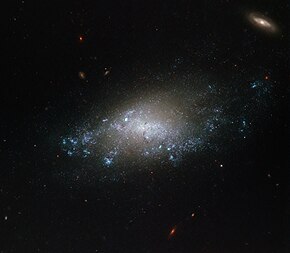NGC 3274 is a relatively faint spiral galaxy discovered by Wilhelm Herschel in 1783, and is located over 20 million light-years away in the constellation of Leo.[4]
| NGC 3274 | |
|---|---|
 NGC 3274, imaged by the Hubble Space Telescope | |
| Observation data (J2000 epoch) | |
| Constellation | Leo |
| Right ascension | 10h 32m 17.281s[1] |
| Declination | +27° 40′ 07.59″[1] |
| Redshift | 0.001791[2] |
| Heliocentric radial velocity | 537[2] |
| Distance | 42.82 ± 27.52 Mly (13.129 ± 8.438 Mpc)[2] |
| Apparent magnitude (V) | 12.32[2] |
| Absolute magnitude (V) | −17.88[2] |
| Characteristics | |
| Type | SABm[3] |
| Size | 27,300 kly (8,360 kpc)[2] |
| Apparent size (V) | 2.188′ × ?′ |
| Other designations | |
| UGC 5721, MCG+05-25-020, PGC 31122 | |
References
edit- ^ a b Skrutskie, Michael F.; Cutri, Roc M.; Stiening, Rae; Weinberg, Martin D.; Schneider, Stephen E.; Carpenter, John M.; Beichman, Charles A.; Capps, Richard W.; Chester, Thomas; Elias, Jonathan H.; Huchra, John P.; Liebert, James W.; Lonsdale, Carol J.; Monet, David G.; Price, Stephan; Seitzer, Patrick; Jarrett, Thomas H.; Kirkpatrick, J. Davy; Gizis, John E.; Howard, Elizabeth V.; Evans, Tracey E.; Fowler, John W.; Fullmer, Linda; Hurt, Robert L.; Light, Robert M.; Kopan, Eugene L.; Marsh, Kenneth A.; McCallon, Howard L.; Tam, Robert; Van Dyk, Schuyler D.; Wheelock, Sherry L. (1 February 2006). "The Two Micron All Sky Survey (2MASS)". The Astronomical Journal. 131 (2): 1163–1183. Bibcode:2006AJ....131.1163S. doi:10.1086/498708. ISSN 0004-6256. S2CID 18913331.
- ^ a b c d e f "NASA/IPAC Extragalactic Database". Results for NGC 3274. Retrieved 12 February 2017.
- ^ "NGC 3274". SIMBAD. Centre de données astronomiques de Strasbourg. Retrieved 12 February 2017.
- ^ "Hubble Spies Spiral Galaxy". NASA. November 22, 2016. Retrieved November 22, 2016.
External links
edit- Media related to NGC 3274 at Wikimedia Commons